Diaries of work
Islands
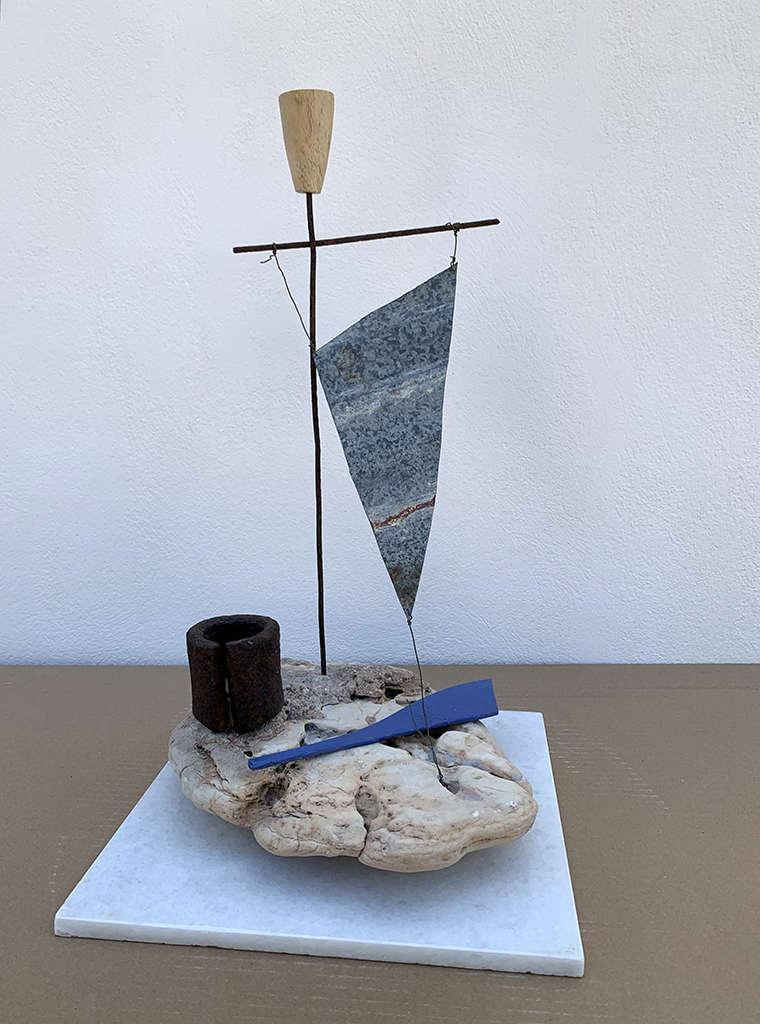
When one approaches an island, one often gets the impression that it is the island itself which is sailing towards the boat.
Greek islands: with masts and sails, with oars and rudders, windmills, driftwood and beach wreckages.
In the myth, the first island to stop wandering around was Delos: “four distinct columns arose from the bottom of the sea and with their capitals on top they supported the rock on iron pillars” (Pindaro).
In this Greek sea, full of sweetness and violence – Latona gave birth to Apollo right in Delos in fact – the flag carries a cross. But a ship’s mast with a yardarm has the same shape as well.
That’s how I finally gave voice to those fragments of rock which I had collected some time ago along the coasts of Klidò, in Naxos.
All it required was the courage of essentiality: a small marine creche that tells the story of the archipelago of wandering islands.
Naxos, 3. 7. 2023
Tripodi Naviganti
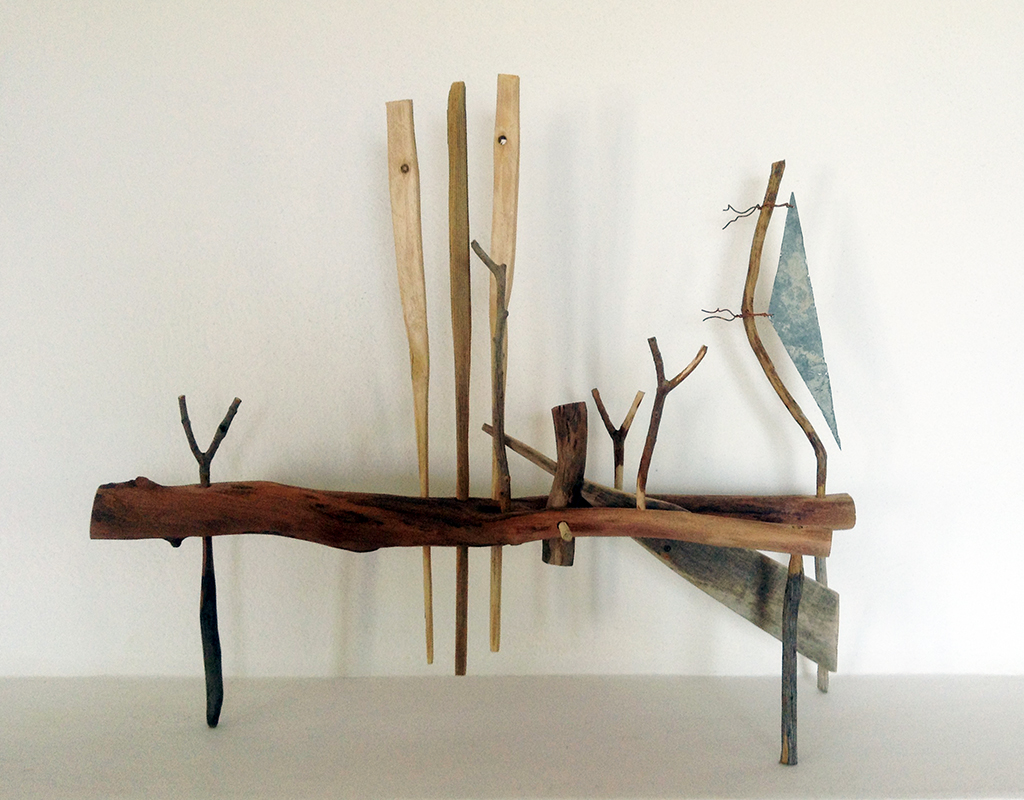 Un tronco flottante divenne barca;
Un tronco flottante divenne barca;
lo scalmo divenne forca;
Il remo divenne pala da forno;
la barca divenne tavolo;
il mare porto’ l’agricoltura;
Poseidone porto’ Demetra.
Patrizio Bedon
Diari di lavoro, Naxos, luglio 2019
Clocks
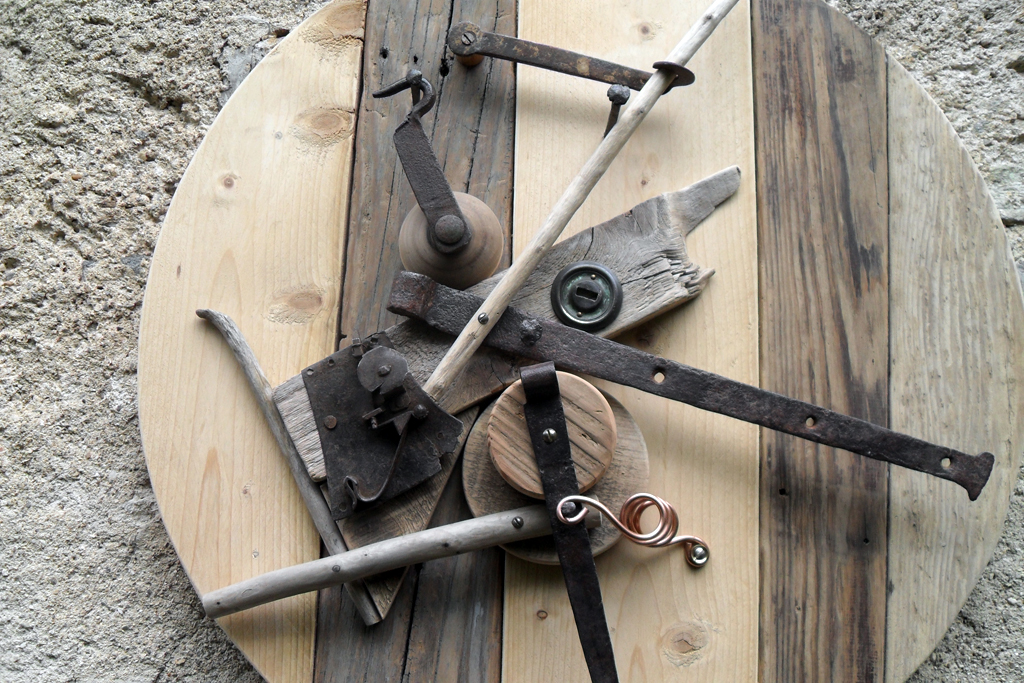
I’m thinking of the far-fetched dream of freezing time and of those who love life far too much, even if they waste it.
In this way, depleted materials give birth to fake mechanisms, assigning fairy-tales of eternity to nostalgia.
These clocks are stuck clocks, nailed down on unknown and illegible hours, possibly those which represent the end of the journey.
But whilst working I’m taken up by the game, and I find myself smiling.
Cerro
January 12, 2019
Patrizio Bedon
Cerro, 12 gennaio 2019
Macchine del tempo
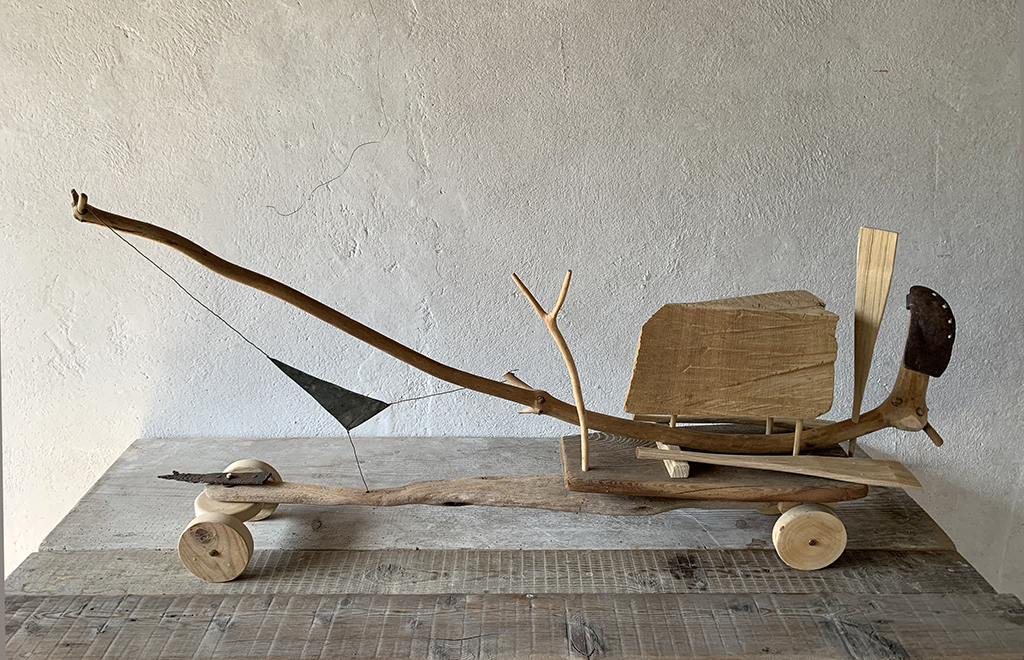 Il tema del viaggio come metafora della vita e’ anche qui, come nelle mie navi. Queste macchine sono come giocattoli, e il gioco consiste nel trasportare ricordi sotto forma di frammenti dimenticati, pezzi di oggetti ormai consumati e destinati all’oblio.
Il tema del viaggio come metafora della vita e’ anche qui, come nelle mie navi. Queste macchine sono come giocattoli, e il gioco consiste nel trasportare ricordi sotto forma di frammenti dimenticati, pezzi di oggetti ormai consumati e destinati all’oblio.
Anche i ricordi sono spesso frammentati, e bisogna accontentarsi. Ma questo trasporto di frammenti – persone ha molto a che fare col teatro e anche col cinema. Penso al Carro di Tespi, che trasportava un multicolore e disordinato campionario di attori girovaghi, come girovago era anche Zampano’ nel film di Fellini (La Strada) su di uno sgangherato motocarro a tre ruote. Nel viaggio siamo tutti un po’ attori di uno spettacolo, con sospette o sconosciute regie.
Patrizio Bedon
Cerro, 13 gennaio 2019
Skyscrapers
I have witnessed the many stages of human environmental invasion.
I see in skyscrapers a huge symbolic presence of this hybris which is getting more and more devastating.
Minimal fragments, surviving material memories are bound to copper threads like plumb lines (maybe, almost…).
New branches of hazel trees, those old Neolithic arrows, now become slender pillars holding cathedral spires, ziggurat, Aztec pyramids and antennas.
Stilts have overgrown, yet they still carry the fragility and the melancholic poetry of an abandoned plaything.
Patrizio Bedon
Cerro, marzo 2020
Landscapes
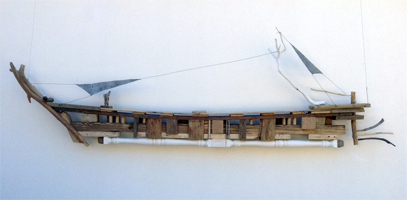
Second boat of this late spring in Naxos.
From a heap of wood on the outskirts of a village in the inner land, some turnings, which were possibly part of a demolished fence from a Turkish mezzanine, were spotted. They have become the keel of the boat, white like the tree so bent with the wind exposing its roots.
White phantoms, brought together in colour, evoking distant epochs, times when one could still talk about landscape. The landscape. An aesthetic and ethical balance between man’s labour and raw nature.
The beautiful and the good, as the Greeks would have it. Landscape as a place of balance, testimony of the gone past times in which humanity was not plundering the planet like they are doing now, with sure suicidal instinct.
Patrizio Bedon
Azalas, Naxos, End of May, 2018
Winds and Keels
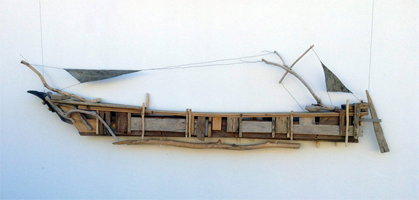
I think how the wind is always present and protagonist of my ships. All of them are equipped with sails, where the masts like trees are bowed and almost uprooted following the direction of the wind. The wind has the symbolic power of immutability: it exists, unchanging, since ever.
But this illusion of eternity clashes with the more current view of the wind seen as destiny, like an uncontrolled power that sweeps away. The wind as “permanence” and
the wind as “no more”. We could say a lot about the keels of the ships: hidden parts normally invisible unless in shipyards where damaged ships are healed. I’m thinking of a mythical ship -probably the most famous of all in antiquity- which had wood
fragments, from Dodona’s sacred woods, inserted in the keel. This sacredness of the keel’s beam, brings my imagination to an extension of time, as the trunk of the tree, before being transformed into a keel, was primitive craft of some type of ancient man.
The holiness of this wood brings us back to the symbolic extension of time. The tree comes back again, like an archetype on the bottom of my ship, and once more eliminates the line of separation between land and sea. Histories of keels, hidden things which usually we cannot see.
Patrizio Bedon
Work Journal, Naxos, July 3, 2018
Foating rooms
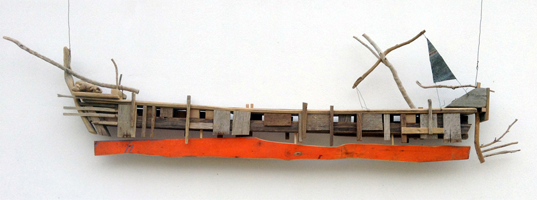
The last ship with a succession of cells and small windows like rooms, remind us of the transfer of populations, always actual. But the rooms are first of all individual places, mental and inner places of memories, remembrance of real houses where once people
were living and had somewhere abandoned, may be forever. But sometimes the ship ceases to be a place of temporary journey, of dramatic departures and becomes a permanent stay, a place of monastic peacefulness. The ship as a home, with all his quiet rooms. The opposites meet each other. Beside we find other ships: a sort of
floating palaces for greedy tourists. But my ships never meet them.
Patrizio Bedon
Naxos, May 2018
Sulla scia delle mie navi
Sempre sulla scia delle mie navi, procedo tra dubbi di rotta e gioie di piccoli e fortunati approdi estetici. La prora, la poppa, l’alberatura, le vele, il fasciame, la carena, il timone, la polena: su questi elementi fisici costitutivi si innestano le costruzioni simboliche, si organizzano e si snodano i racconti attraverso ingrandimenti, riduzioni, allusioni, sovrapposizioni, confronti, sostituzioni, citazioni.
La polena indirizza la corsa, con volto di asino o becco di uccello. Forse un gabbiano, o un migratore: appesa a mezz’aria la nave sta davvero volando (ma anche gli asini volano, come sanno bene i bambini). Per lo più le polene avevano volto di donna, il volto del desiderio inappagato. Anche per questo le mie polene sono sempre più grandi. Una presenza isolata a poppa ricorda il navigatore solitario. Quello famoso, che però non ha un nome. Un chiodo, un niente, nessuno.
Il naufragio in perenne divenire senza mai concludersi e’ il motivo conduttore sempre presente nelle fiancate lacerate e nella prua spalancata dall’urto delle onde. Bocca di pesce affamato. Un vomere d’aratro a prua ricorda che thalassa non è solo mare, ma vuol dire anche pianura. Volos e’ in Tessaglia. Da lì partì Giasone con i suoi Argonauti per il primo viaggio avventuroso della storia lasciando il certo per l’incerto. Lasciando il grano della Tessaglia per cercare l’oro. Di nuovo mare e campagna si confondono. Da tempo l’albero maestro e’ un albero vero, ormai. Eroe solitario e molto piegato dal vento della storia, con radici che affondano disperatamente nella tolda. Una fila di denti a prua, una coda sfrangiata a poppa come timone:pesci e navi hanno destini che si incrociano e si sovrappongono. Le vele sono sempre più piccole, come se la nave procedesse d’inerzia per una specie di forza intrinseca, o del destino. Le carene vivono separate, stanno per conto loro : una separatezza che poi è la loro vera natura di vita sommersa. Le bitte sulle fiancate ricordano gli ormeggi dei porti. Come se la nave attendesse l’arrivo di un porto e non viceversa. Punti di vista; storie di viaggi e di approdi impossibili.
Naxos, Azalas, luglio 2016
Da una lirica greca
Mi sono chiesto spesso quali fossero le ragioni di questo mio attaccamento alla Grecia, così forte che mi ha spinto a comprare una casa lì e a trascorrervi una buona parte dell’anno. Forse la ragione più vera sta in una lirica che ci lesse al liceo il professore di greco, uno dei pochi professori di allora, se non l’unico, umanamente ricco e anche per questo culturalmente determinante. Era la descrizione minuta e semplice del rapporto inconsueto tra un uomo solitario e un topo. La descrizione di una piccola cosa quotidiana, della quale però non si fatica ad intuire la grandezza potenziale. Da allora, della Grecia mi ha sempre attratto l’aspetto minimalista, il radicamento all’essenziale dell’esistenza che consente di scoprire, nel piccolo, una chiave di comprensione simbolica, morale e affettiva del grande mistero dell’esistenza.
Ci sono ancora, non so quanto dureranno, angoli del mondo dove permane il rapporto armonico dell’umano con la natura. In questo senso, nel senso del paesaggio come lo si intendeva storicamente, la Grecia resta un esempio forte. Persino Atene, che è sempre stata una metropoli, fino a poco tempo fa conservava nei suoi cafenion un’atmosfera analoga a quella che si poteva cogliere nei villaggi agricoli. Questo sconfinamento della campagna nella città, che altrove era tramontato da tempo, la dice lunga sul senso profondo di una civiltà come quella greca, profondamente legata alla Madre Terra come elemento primario. Forse non è un caso che a Nasso, l’isola che ho scelto, in uno stupendo angolo interno di campagna, esista un tempio dedicato a Demetra. Prima di Fidia, prima e dopo Fidia il Partenone e Costantinopoli, sono esistiti i villaggi greci e la scansione quotidiana di un’esistenza non ancora suicida.
Credo che anche il mio fare artistico nasca proprio da qui, da questa Grecia minimale. Non dalla Grecia classica, dal Partenone o da Costantinopoli, non dalla idealizzazione di un popolo greco “speciale”. La mia è stata solo l’occasione di cogliere, da una semplice lirica, ciò che mie servito per essere quello che sono. Da una lirica greca.
Cerro, novembre 2016
Ships
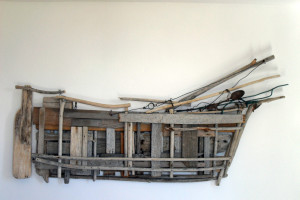
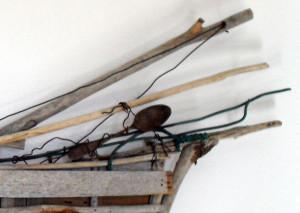
The boat is primarily a symbol of journey. Life is a journey. With some shipwreck along the way. It is the same shipwreck which transforms materials, changing shapes.
Transforming is surely not rebirthing, but one moves on courageously carrying one’s stuff, known and worn, in order to reinvent form, to rediscover a way.
Small pieces of wood with minute stories whose meaning one can only guess. All such stories communicate with one another, remembering the child who used to make small boats out of bread crumbs.
A fishing boat with a spoon attached to its prow. One travels to understand, one runs risks searching for food. One emigrates. One colonizes. Poor souls or argonauts, “cake walking babies from home”: a title of a traditional jazz number which I found in one of my time machines that carries a wooden ladle.
But this taste of food is neither the one referred to by Proust, nor is it a banquet. It pertains to the good and the beauty, outside the realm of time: the secret of the sailor saved by the waves.There comes a ship loaded with bread.
Naxos, 18 May, 2012
Trees
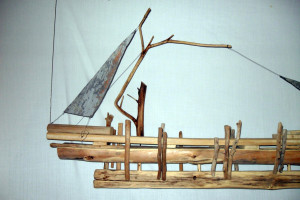
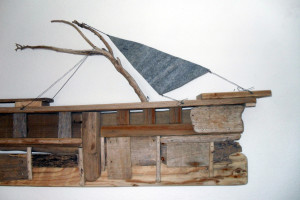
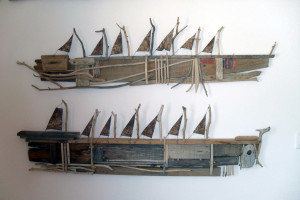
Sometimes one thinks of the story of certain trees grown in the countryside or in the woods, whose fate suddenly changes, ending up traveling up and down the seas. They became masts: the wooden ones of times gone by.
In this way the farmer leaves the field, travels to the harbour to become a sailor, carrying a pouch with few belongings, such story of the journey of life being represented in the naval museum of Barcellona.
Parallel journeys that override the traditional distinction between the seaside and the countryside. Maybe it is for this reason that the most beautiful countrysides are by the sea.
In this way branches grow on the main mast and on the bowsprit and in the meantime more trees grow on the ship: seven masts, nine masts; a sailing wood.
But life finishes after the last storm. A huge tree grows on the wreck that stands on the seabed, with all its branches stretched out, on which fish lay.
Naxos, June 2012
Wheels
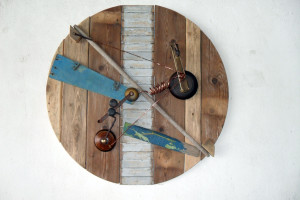
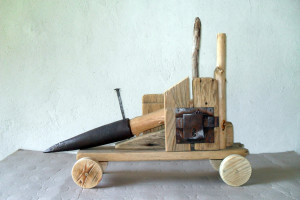
The lathe is a wheel that turns. It is the mother of all wheels. Wagon wheels, car wheels and clocks. It is a dominant icon of technology. It marks the shift from prehistory to history, which until recently has been mostly agricultural.
Even my time machines have wheels. Wooden wheels, toy wheels that bring memories, connecting far and different worlds, past and future.
My original passion for the lathe, the mother of all wheels, has taken me through these adventurous roads of analogies and nostalgia.
Cerro, 6 February, 2013
Small goats
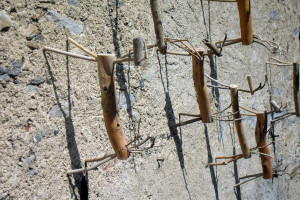
I have created a small herd of sheep, animals that look like wooden toys from the old times. They climb walls possibly to escape from being slaughtered, or else it could also be that their souls have already departed. The suffering of animals is just like the suffering of children: an old toy talking silently. Naxos, July, 2011

